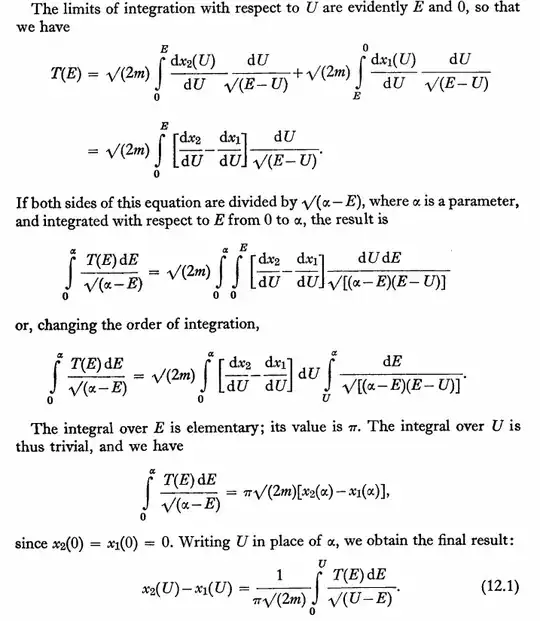First of all, I think there is no name for this as a technique.
This technique is, IMHO, not to be remembered, because the same result can be achieved with Laplace Transform through a more direct path.
The basic observation is that convolution operation is hidden everywhere. The function (or, better said, distribution) with which one "convolves" is :
$$K(E):=\dfrac{1}{\sqrt{E}}.$$
You find a convolution by this function $K$ as well :
Remark : These convolutions are in the sense of "causal" functions (all concerned functions are zero for negative values of the variable): see edit at the bottom.
This induces the fact that this computation can entirely be done using Laplace Transform (and convolution !) taking into account the fact that L.T. of $\dfrac{1}{\sqrt{t}}$ is $\sqrt{\pi}\dfrac{1}{\sqrt{s}}$ (see for example this).
Here is the detail of the computation:
Let us convolve equ. (1) by $K$ .
$$T * K = \sqrt{2m}(x_2 - x_1)' * K * K.$$
Now we take the L.T. of the RHS (only): $\sqrt{2m} s(X_2-X_1).\dfrac{\pi}{s}$
The two $s$ cancel ; taking now the inverse L.T., one gets $\sqrt{2m} (x_2-x_1).\pi$, which, equated with $T * K$, gives an equation equivalent to (2), as desired.
More economical than the method of Landau and Lifshitz (very witty, for sure), isn't it ?
Remarks : 1) Convolution by $K$ is equivalent to the operation of mult. by $\dfrac{1}{\sqrt{\alpha - E}}$ in L. & L. computation.
2) Have you noticed where $\pi$ has crept into the computations ?
Final remark: I have been looking for a specific integral transform (like Mellin transform) that could also explain things, but I have found nothing till now.
Edit: What is the difference between the "ordinary" convolution:
$$(f*g)(x):=\int_{t=-\infty}^{\infty}f(t)g(x-t)dt \ \ \ (3)$$
and the convolution of causal functions "defined" by
$$(f*g)(x):=\int_{t=0}^{x}f(t)g(x-t)dt \ \ \ (4)$$
Its very simple; it comes from the fact that one can always write a causal function into the following form $h(t)=U(t)h(t)$ where $U$ is the Heaviside step function ($U(t)=0$ for $t<0$, $U(t)=1$ for $t\geq 0$).
Therefore, when we deal with causal functions, (3) can be written under the following form:
$$(f*g)(x)=\int_{t=-\infty}^{\infty}(U(t)f(t))(U(x-t)g(x-t))dt$$
$$=\int_{t=-\infty}^{\infty}V(t)f(t))g(x-t)dt$$
Where $V(t):=U(t)U(x-t)=1$ iff $t \in [0,x]$, and $V$ is zero elsewhere : $V$ is the characteristic function of interval $[0,x]$. We can of course make $V$ disappear by taking into account it in the bounds of integration, yielding relationship (4).
